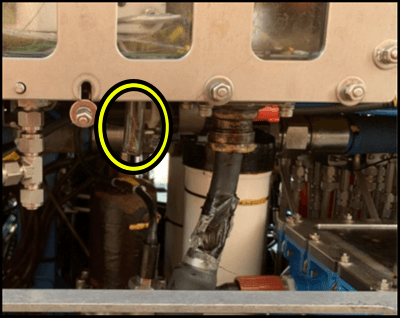-
What happened?
Remotely operated vehicle (ROV) technical personnel were working in the workshop completing a non-electrical task.
The ROV single phase power was energised, but the area of the ROV (Phase 3) that was being worked on was isolated, de-energised and locked out.
When bleeding air on top of the high pressure filter housing from the main hydraulic circuit, the technician received an electric shock to his left arm beneath the elbow, resulting in a burn.

-
Why did it happen?
A water drain tube had been used as a conduit for an electrical cable.
The routing of the electrical cable through the water drain was a modification to the system that had not been documented or communicated.
The electrical cable, which had been cut, exposed the bare wires rather than being disconnected and removed.
The cut wires were connected to a separate transformer, and so the wires were found to be live.
It was unclear whether or not the cut happened during demobilisation, transit, or during the skid and ROV segregation in the technical workshop.

-
What did they learn?
All electrical cables should be properly disconnected and/or removed, not cut, when demobilising equipment.
System modifications should be noted within drawings and system paperwork.
Major system modifications should follow a formal management of change (MoC) process, which is the responsibility of the supervisor on site.
There should be a documented handover between the offshore supervisor and technical workshop supervisor, including details of any system modifications and instructions for disconnection and removal.

-
Ask yourself or your crew
When have you discovered something unexpected that should have been reported?
Do you expect to encounter undocumented modifications? How can we manage these?
What would you do differently if you needed to remove an electrical cable?
When doing non-electrical tasks on electrical equipment, how do you know it is safe?

Add to homescreen
Content name
Select existing category:
Content name
New collection
Edit collection
What happened?
Remotely operated vehicle (ROV) technical personnel were working in the workshop completing a non-electrical task.
The ROV single phase power was energised, but the area of the ROV (Phase 3) that was being worked on was isolated, de-energised and locked out.
When bleeding air on top of the high pressure filter housing from the main hydraulic circuit, the technician received an electric shock to his left arm beneath the elbow, resulting in a burn.

Why did it happen?
A water drain tube had been used as a conduit for an electrical cable.
The routing of the electrical cable through the water drain was a modification to the system that had not been documented or communicated.
The electrical cable, which had been cut, exposed the bare wires rather than being disconnected and removed.
The cut wires were connected to a separate transformer, and so the wires were found to be live.
It was unclear whether or not the cut happened during demobilisation, transit, or during the skid and ROV segregation in the technical workshop.
What did they learn?
All electrical cables should be properly disconnected and/or removed, not cut, when demobilising equipment.
System modifications should be noted within drawings and system paperwork.
Major system modifications should follow a formal management of change (MoC) process, which is the responsibility of the supervisor on site.
There should be a documented handover between the offshore supervisor and technical workshop supervisor, including details of any system modifications and instructions for disconnection and removal.
Ask yourself or your crew
When have you discovered something unexpected that should have been reported?
Do you expect to encounter undocumented modifications? How can we manage these?
What would you do differently if you needed to remove an electrical cable?
When doing non-electrical tasks on electrical equipment, how do you know it is safe?
Worker working on a remotely operated vehicle suffered electric shock due to an undocumented electrical modification.












